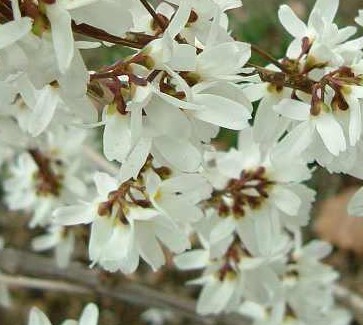 Native to a small area in central Korea, this deciduous shrub is considered “critically endangered’ in the wild but is a popular garden plant in cultivation. It produces clusters of small almond scented flowers in very early spring on leafless purple black stems. The flowers have four white to pinkish petals and yellow stamens. The leaves are glossy, dark green and 2-3.5″ long. White forsythia is a member of the olive family, Oleaceae, and related to the more familiar yellow forsythia which it resembles. Stems bearing flower buds can be forced for a winter display.
Native to a small area in central Korea, this deciduous shrub is considered “critically endangered’ in the wild but is a popular garden plant in cultivation. It produces clusters of small almond scented flowers in very early spring on leafless purple black stems. The flowers have four white to pinkish petals and yellow stamens. The leaves are glossy, dark green and 2-3.5″ long. White forsythia is a member of the olive family, Oleaceae, and related to the more familiar yellow forsythia which it resembles. Stems bearing flower buds can be forced for a winter display.
Type: Deciduous shrub
Outstanding Feature: Flowers in very early spring
Form: Sprawling
Growth Rate: Slow to moderate
Bloom: Racemes of small white to slightly pinkish flowers appear in very early spring.
Size: 3-10’ H x 3-10’ W
Light: Full sun; tolerates some shade
Soil: Fertile, medium moist, well drained; does not tolerate drought.
Hardiness: Zones 5-9
Care: Prune after flowering removing up to one third of the canes as needed. Hard pruning every three to four years controls twiginess.
Pests and Diseases: None of significance
Propagation: Semi-ripe cuttings in mid-summer; layering in summer.
Outstanding Selection: ‘Roseum’ (pale pink flowers)
Photo Credit: Wikipedia
